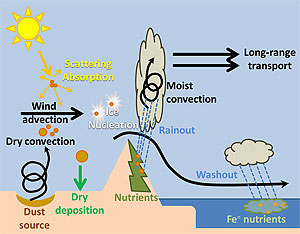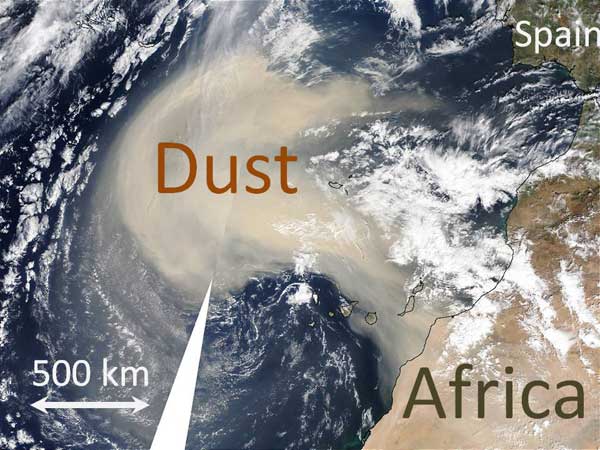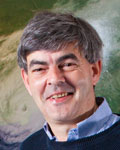Mineral Dust Cycle
Mineral dust in the atmosphere is composed essentially of clay and silt particles, whose diameters vary between 0.1 to 20 micro-meters (~1/10 of hair). Larger particles, such as sand, are not included because they are too quickly removed from the atmosphere by gravitational settling.
The main sources of silt and clay are in topographic depressions where alluvium has been accumulated. Dust is emitted when the surface winds are strong enough to break soil cohesion, which may only happen if there is no ground cover and the soil is dry. Human activities may be a source of dust or disturb soils and enhance wind erosion.
Dust is removed from the atmosphere by wet deposition (i.e. scavenging through precipitation in the water or ice phase) or through impaction of the Earth’s surface by turbulence. The lifetime of dust particles in the atmosphere is of the order of one week, over which period they can be transported several thousand kilometers by winds.
 During their transport, they affect the Earth’s radiation balance by scattering (dust particles diffuse light in all directions but mostly forward) and absorbing (dust plumes appear yellowish because they absorb mostly the blue wavelengths) solar radiation, and also by absorbing part of the terrestrial longwave radiation (they trap, like Greenhouse gases, thermal radiation). They play an important role in cloud nucleation (dust particles act as cloud and ice nuclei), therefore affecting cloud lifetime and optical properties.
During their transport, they affect the Earth’s radiation balance by scattering (dust particles diffuse light in all directions but mostly forward) and absorbing (dust plumes appear yellowish because they absorb mostly the blue wavelengths) solar radiation, and also by absorbing part of the terrestrial longwave radiation (they trap, like Greenhouse gases, thermal radiation). They play an important role in cloud nucleation (dust particles act as cloud and ice nuclei), therefore affecting cloud lifetime and optical properties.
Mineral dust is believed to play an important role in many marine and terrestrial biogeochemical processes. Trace metals on dust are important nutrients for the development of ecosystems.
Dust concentration can be so high during dust storms that it affects air quality, and pose public health problems; in particular it has been suggested that dust is playing an important role in developing meningitis outbreaks in Sahel.
Objectives
The main objectives of the “Mineral Dust Cycle” theme are:
- To determine natural and anthropogenic dust sources, and environmental controls,
- To improve physical representation of dust interactions with clouds and radiation in models,
- To improve dust modeling for past (including Last Glacial Maximum), present and future climates,
- To study dust impacts on radiation and cloud properties for past, present and future climates,
- To assess dust impacts on ocean biogeochemistry,
- To study dust impacts on ozone photochemistry,
- To assess dust impact on health.
Research Activities
These activities are conducted along seven axes of research:
- Dust source inventories
- Dust interactions with clouds and radiation
- Dust interactions with ecosystems
- Dust in past and present climates
- Dust prediction from seasonal to decadal
- Dust and chemistry
- Dust and health




